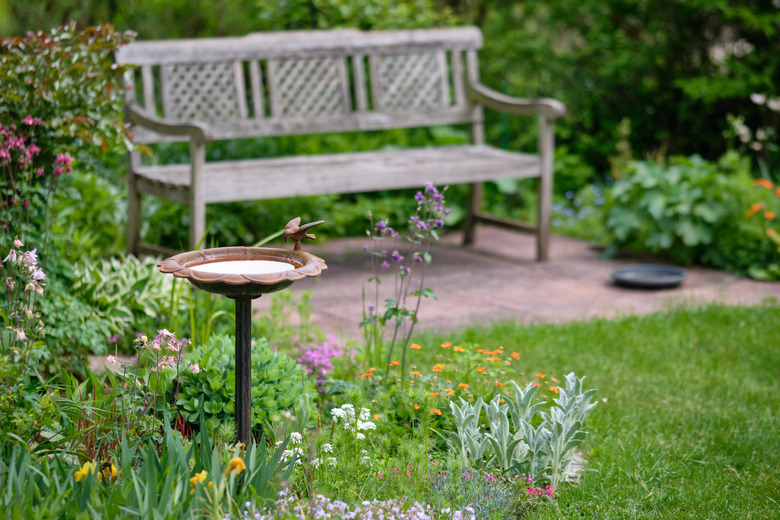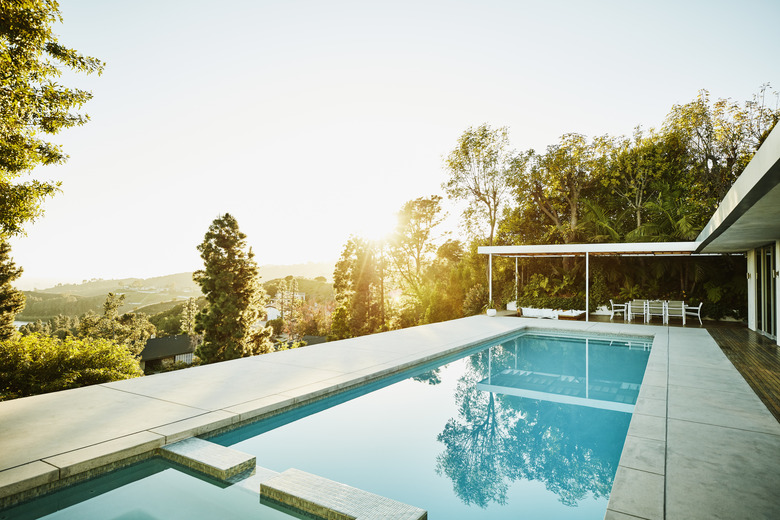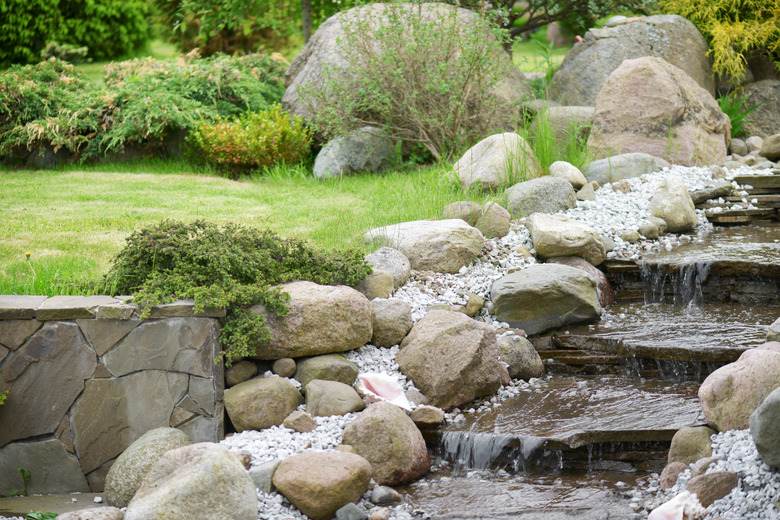A Homeowner's Guide To Outdoor Water Features
We may receive a commission on purchases made from links.
The soothing sound of flowing water calms the mind and relaxes the body. You can add this gentle pleasure to your own backyard by putting in water features like garden fountains, bubblers, koi ponds, large or small streams or even backyard waterfalls.
Installing a water feature in your outdoor space creates an instant sense of tranquility and adds interest and even drama to your landscape. Whether you are thinking of having a water feature installed professionally or you prefer jumping into a DIY project, there are many options available.
Backyard Pond for Koi
Backyard Pond for Koi
Did you ever notice how many dental offices have fish tanks? That's because watching fish swim relieves stress. You can get the same serenity in your backyard by installing a koi pond. Classic Japanese koi are beautiful fish that are white or silver with spots of orange and red, but there are a number of types of koi that are different colors. All do best living in groups, sometimes paired with goldfish or catfish for companions.
A koi pond should be made from concrete with a rubber lining and a muddy bottom substrate. Keep in mind that this is not a small water feature. Each adult fish will grow to about 3 feet long and will require some 250 gallons of water. The pond must be at least 6 feet deep, with some shallow areas and some deeper areas.
The pond will be a better home for fish and a more attractive water feature if it is a water garden as well. Some great plants to include are water hyacinth, floating pondweed and pickerels.
Using Backyard Waterfalls
Using Backyard Waterfalls
Backyard waterfalls are among the most popular water feature ideas. Water rushing over rocks or tumbling from a height into a small pond is inherently soothing. Larger cascades throw up mist, cooling down a hot summer afternoon. A waterfall of any size adds ambiance and a sense of luxury to your landscape and serves as a wonderful focal point in a backyard.
There are a dazzling array of waterfall designs, from small waterfalls that empty into shallow pools to larger versions with multiple cascades. In some, water tumbles over layered slabs of stone, and in others, it splashes against boulders or pours over a vertical cliff. Most backyard waterfalls have a higher section where the water flow begins and a lower pond section into which it falls.
An important consideration when planning a DIY waterfall is how to achieve the necessary elevation. You could use an existing slope, or if none is present, you could erect an artificial slope. When building large outdoor waterfalls, you have to use a flexible liner to channel the water and then cover the liner with boulders or rocks. For a small waterfall, consider stacking precast concrete forms that look like stone for the cascading structure.
Birdbath Water Feature
Birdbath Water Feature
If you want a water feature that is relatively inexpensive and serves a more-than-ornamental purpose, consider a birdbath. Birdbaths are essential water features for the yards of wildlife lovers, and they are simple to install. There are no filters to install and no pumps. That makes a birdbath an easy DIY water feature project to spiff up your outdoor living space.
If you plan to purchase a birdbath, you'll find many options from which to choose, including pedestal, tabletop and hanging birdbaths, but it's fun to use your imagination and create a one-of-a-kind birdbath out of repurposed materials. You might use flower pots or fruit bowls placed on concrete form tubes, upright logs or even old tomato cages or stepladders to build in some height. Some people use old sinks, lamps or rice cookers. Let your inner child get creative with this one.
Whether you are buying or making your birdbath, remember to keep the birds' interests in mind. Birds prefer rough, nonslip surfaces like concrete or terra cotta instead of glazed pottery, and 3 inches deep is plenty. Adding a dripper that adds water slowly to the bath will attract more birds and also bring the soothing sounds of water dropping into water.
Using Garden Fountains
Using Garden Fountains
Fountains are a popular and versatile water feature that add a new sensory experience to your yard. The right fountain can serve as a focal point for a backyard and can transform it into a serene retreat as guests relax to the gentle sounds of trickling water. These popular water features come in many different sizes, from tiered estate fountains with multiple spouting elements to compact, self-contained fountains for smaller yards. You can even find fountains that mount on walls. Most are built with conventional electric pumps, but solar fountains are also available.
How do you choose a fountain? Consider your backyard space, your budget and your garden style. Generally, large fountains are meant to serve as the centerpiece of a garden, while smaller ones serve as accent pieces. The most popular materials for fountain construction are cast stone, fiberglass, ceramic and metal, and each will create a different ambiance. For DIY projects, you can mix and match these materials to create a unique look.
Using Fire Fountains
Using Fire Fountains
One popular garden fountain is so extraordinary that it deserves special mention. That is the fire fountain, and these days, it's a hot-ticket item. These self-contained water features blend the drama of a crackling fire with its flickering flames and the tranquility of water flow and splashing gurgles.
Why doesn't the water extinguish the flames? Some products do not actually mix these elements but rather keep them separate. Other products use a type of fire fountain technology where the fire is literally on the water. The design lets gas leave the base but prevents water from backing up into the gas line.
Fire fountains use different types of fuel, from paraffin lamp oil to propane. Some come with an automatic ignition system that allows you to light the flame by pushing a button in any weather conditions, while others require you to light them manually.
Homeowners who are interested in this water feature can purchase a self-contained unit or build their own, buying the fountain first and then retrofitting the manifold and gas valves. Don't forget that the fire is real, so you'll need a fountain that isn't made of combustible materials. Concrete and cast iron are the most popular materials.
Backyard Swimming Pool
Backyard Swimming Pool
If a swimming pool isn't the most desired backyard water feature of all time, it has to be close. When you add a swimming pool to your yard, your entire landscape transforms into a social center and a happy place. Not only do you get the stunning effect of sunshine glinting off water, you also get a cool dip on a hot summer afternoon, a fun way to get exercise and a special place for family and friends to gather.
Pools can be expensive, but they can potentially add value to a home, so before you jump in, consider the pros and cons of getting the less-expensive, above-ground style. These don't last as long or look as elegant as in-ground pools, but they typically cost half the price and often considerably less. You'll also have less options in terms of depth and shape with an above-ground model, but you don't have to dig up the yard either. An above-ground model doesn't take long to get in place, so you'll be swimming sooner.
On the other hand, an in-ground pool is an investment that can last for decades if it is maintained. You can opt for one of the popular pool shapes, like kidney or rectangle, but you can get a custom design that works perfectly with your landscape. The three most popular types of in-ground pools include pools with vinyl liners, concrete pools and fiberglass pools. The former costs the least up front, but the liner needs regular replacing. Concrete pools need to be resurfaced every decade or so, and fiberglass pools cost the most to install but need little maintenance.
Other water features like bubblers or water slides can be added to a pool as well for extra splash and extra fun. Many homes with large backyards install separate pools and hot tubs in proximity to each other.
Outdoor Water Wall
Outdoor Water Wall
The outdoor water wall is a modern water feature that is guaranteed to catch every eye. It adds visual "pow" and sensory pleasure to your garden.
You won't find one type of water wall but hundreds, all intriguing as vertical surfaces where water dances. Some look like waterfalls, some look like glistening cave walls and some look like full-blown fountains. All bring the music and dazzle of moving water to your garden.
If water walls interest you as design features, take a look online to see the full range of the possible creations included in this category of water features. A water wall might have an unending ribbon of cascading water over a metal, brick or textured wall or a door-frame arch with free-falling curtains of water creating a spectacular, transparent dividing wall within the backyard. It is entirely possible to create your own water wall as a DIY project with glass sheets and wood.
Large or Small Stream
Large or Small Stream
If you dream of living on the banks of a rushing river but find yourself in an urban center, you can create a flowing stream water feature. With enough land, you can build the stream of your dreams, with water laughing and dancing over rocks.
In order to build a stream, you need to let the design integrate itself into the slope, topography and landscaping of your yard. Remember that every stream has a beginning, a flow and an end. It can bubble up from the ground, start at a waterfall or connect two ponds on different levels. Design is key, so it's important to plan a stream to follow a course that a natural stream would have followed. Pick a pump that will move the water through your key features.
If your landscape or budget just won't accommodate a big stream, consider a small stream water feature. This is a shallow water flow constructed along the edges of your patio or garden. You'll get the same sense of current and the same sounds, especially if you include a little waterfall to take the stream down to a lower level from a higher one.
References
- Fishkeeping World: The Ultimate Koi Fish Care And Pond Guide
- PennState Extension: Water for Wildlife: Bird Baths and Backyard Ponds
- Extra Space Storage: 24 Outdoor Water Feature Ideas for Backyards, Gardens, & Patios
- Landscaping Network: Outdoor Fountain Ideas
- Peterson's Landscape & Maintenance Services: FIRE and WATER Fountains: a Popular Landscape Feature that's HOT
- Garden Lovers Club: Spectacular Garden Water Wall Ideas
- Pond Trade Magazine: A How-To Guide: Building a Perfect Stream
- City of Winston-Salem: Splash Pads



